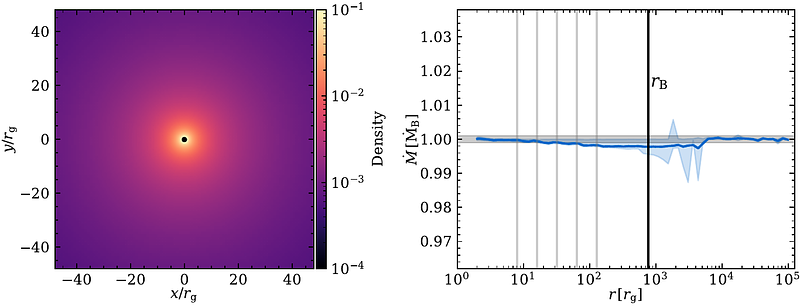Cyclic Zoom: Multi-scale GRMHD Modeling of Black Hole Accretion and Feedback

Cyclic Zoom: Multi-scale GRMHD Modeling of Black Hole Accretion and Feedback
Minghao Guo, James M. Stone, Eliot Quataert, Volker Springel
AbstractWe present a ``cyclic zoom'' method to capture the dynamics of accretion flows onto black holes across a vast range of spatial and temporal scales in general relativistic magnetohydrodynamic (GRMHD) simulations. In this method, we cyclically zoom out (derefine) and zoom in (refine) the simulation domain while using a central mask region containing a careful treatment of the coarsened fluid variables to preserve the small-scale physics, particularly the magnetic field dynamics. The method can accelerate GRMHD simulations by $\gtrsim 10^5$ times for problems with large scale separation. We demonstrate the validity of the technique using a series of tests, including spherically symmetric Bondi accretion, the Blandford-Znajek monopole, magnetized turbulent Bondi accretion, accretion of a magnetized rotating torus, and the long-term evolution of an accreting torus about both Schwarzschild and Kerr black holes. As applications, we simulate Bondi and rotating torus accretion onto black holes from galactic scales, covering an extremely large dynamic range. In Bondi accretion, the accretion rate is suppressed relative to the Bondi rate by $\sim(10r_\mathrm{g}/r_\mathrm{B})^{1/2}$ with a feedback power of $\sim 0.01 \dot{M} c^2$ for vanishing spin, and $\sim 0.1 \dot{M} c^2$ for spin $a\approx0.9$. In the long-term evolution of a rotating torus, the accretion rate decreases with time as $\dot{M}\propto t^{-2}$ on timescales much longer than the viscous timescale, demonstrating that our method can capture not only quasi-steady problems but also secular evolution. Our new method likewise holds significant promise for applications to many other problems that need to cover vast spatial and temporal scales.